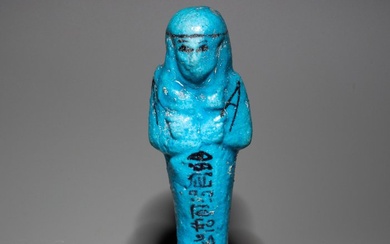Ancient Egyptian Faience Overseer Shabti with inscription in black. Third Intermediate Period. 10,5 cm H.
Overseer Shabti inscription in black. Ancient Egypt Third Intermediate Period, 1070 - 650 BC. Faience Height 10,5 cm PROVENANCE: Old private collection, Sufflok, Great Britain, formed at the beginning of the 20th century. CONDITION: Intact. See photos. DESCRIPTION: Ushabtis, a term which in Ancient Egypt means “answerers”, were figures that directly represented the deceased person. They appeared in the Middle Kingdom and their use became popular in the New Kingdom. They formed part of the grave goods. Chapter VI of the Book of the Dead was often inscribed on the figurine, or a simpler version with the name and title of the deceased. The use of these funerary figures allowed the owner to enjoy the afterlife as the ushabtis acted as a form of worker substitute for the owner in the fields of Aaru, the Egyptian paradise, as the Egyptians believed that the spirits of these figurines would work for them and thus achieve their sustenance in the afterlife. There were 365 ushabtis placed among the grave goods, one for each day of the year. Along with these there might be 36 overseers who would be in charge of each of the workgroups made up of 10 workers, and so avoid any possibility of rebellion in the ranks. Notes: The seller guarantees that he acquired this piece according to all national and international laws related to the ownership of cultural property. Provenance statement seen by Catawiki. - The piece includes authenticity certificate. - The piece includes Spanish Export License. - The seller guarantees that he acquired this piece according to all national and international laws related to the ownership of cultural property. Provenance statement seen by Catawiki.
[ translate ]View it on
Estimate
Time, Location
Auction House
Overseer Shabti inscription in black. Ancient Egypt Third Intermediate Period, 1070 - 650 BC. Faience Height 10,5 cm PROVENANCE: Old private collection, Sufflok, Great Britain, formed at the beginning of the 20th century. CONDITION: Intact. See photos. DESCRIPTION: Ushabtis, a term which in Ancient Egypt means “answerers”, were figures that directly represented the deceased person. They appeared in the Middle Kingdom and their use became popular in the New Kingdom. They formed part of the grave goods. Chapter VI of the Book of the Dead was often inscribed on the figurine, or a simpler version with the name and title of the deceased. The use of these funerary figures allowed the owner to enjoy the afterlife as the ushabtis acted as a form of worker substitute for the owner in the fields of Aaru, the Egyptian paradise, as the Egyptians believed that the spirits of these figurines would work for them and thus achieve their sustenance in the afterlife. There were 365 ushabtis placed among the grave goods, one for each day of the year. Along with these there might be 36 overseers who would be in charge of each of the workgroups made up of 10 workers, and so avoid any possibility of rebellion in the ranks. Notes: The seller guarantees that he acquired this piece according to all national and international laws related to the ownership of cultural property. Provenance statement seen by Catawiki. - The piece includes authenticity certificate. - The piece includes Spanish Export License. - The seller guarantees that he acquired this piece according to all national and international laws related to the ownership of cultural property. Provenance statement seen by Catawiki.
[ translate ]




